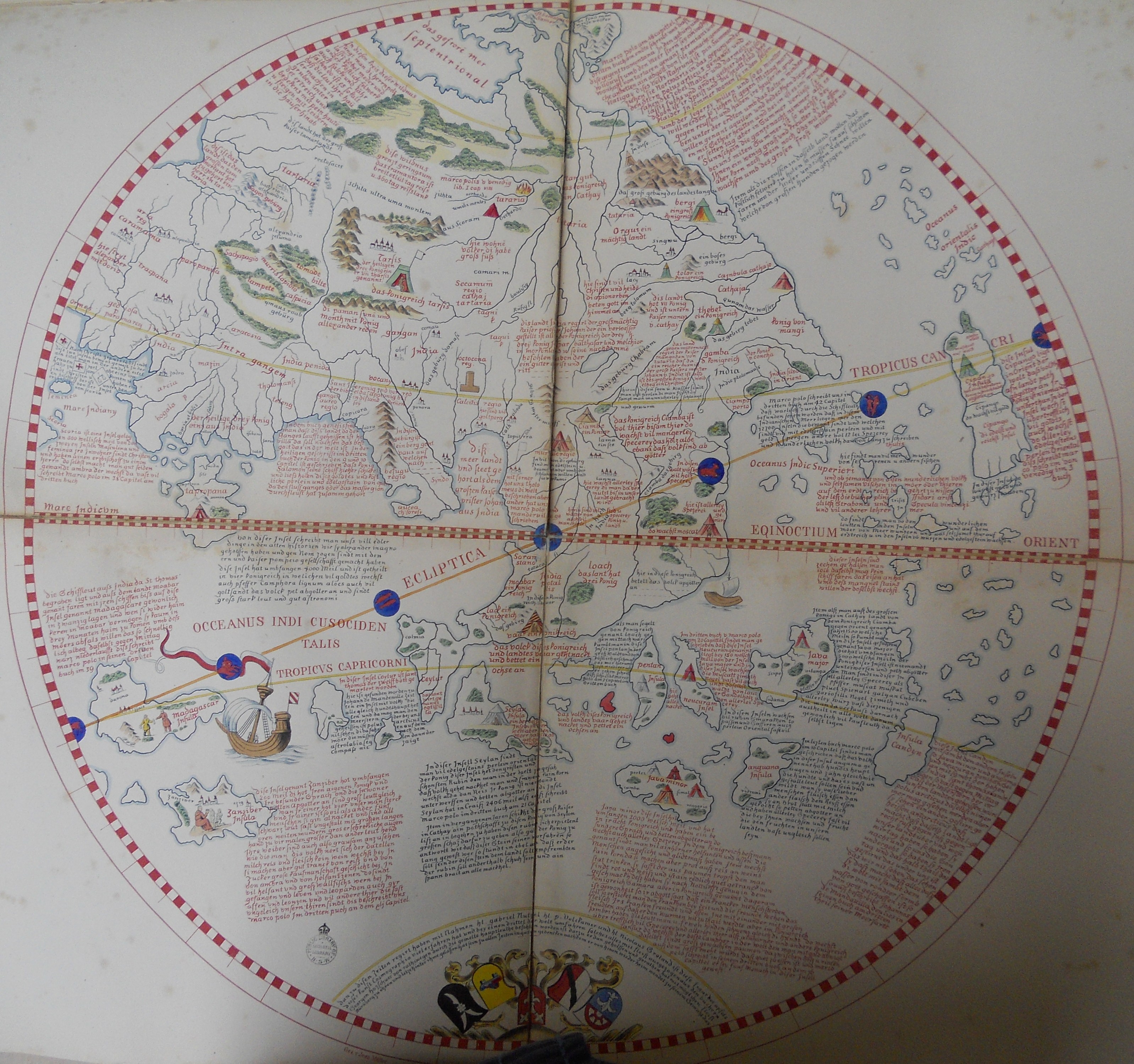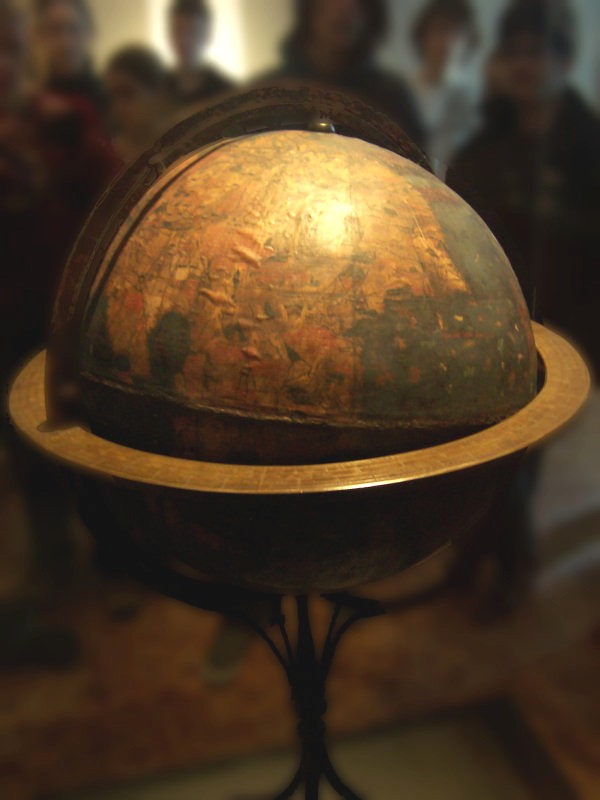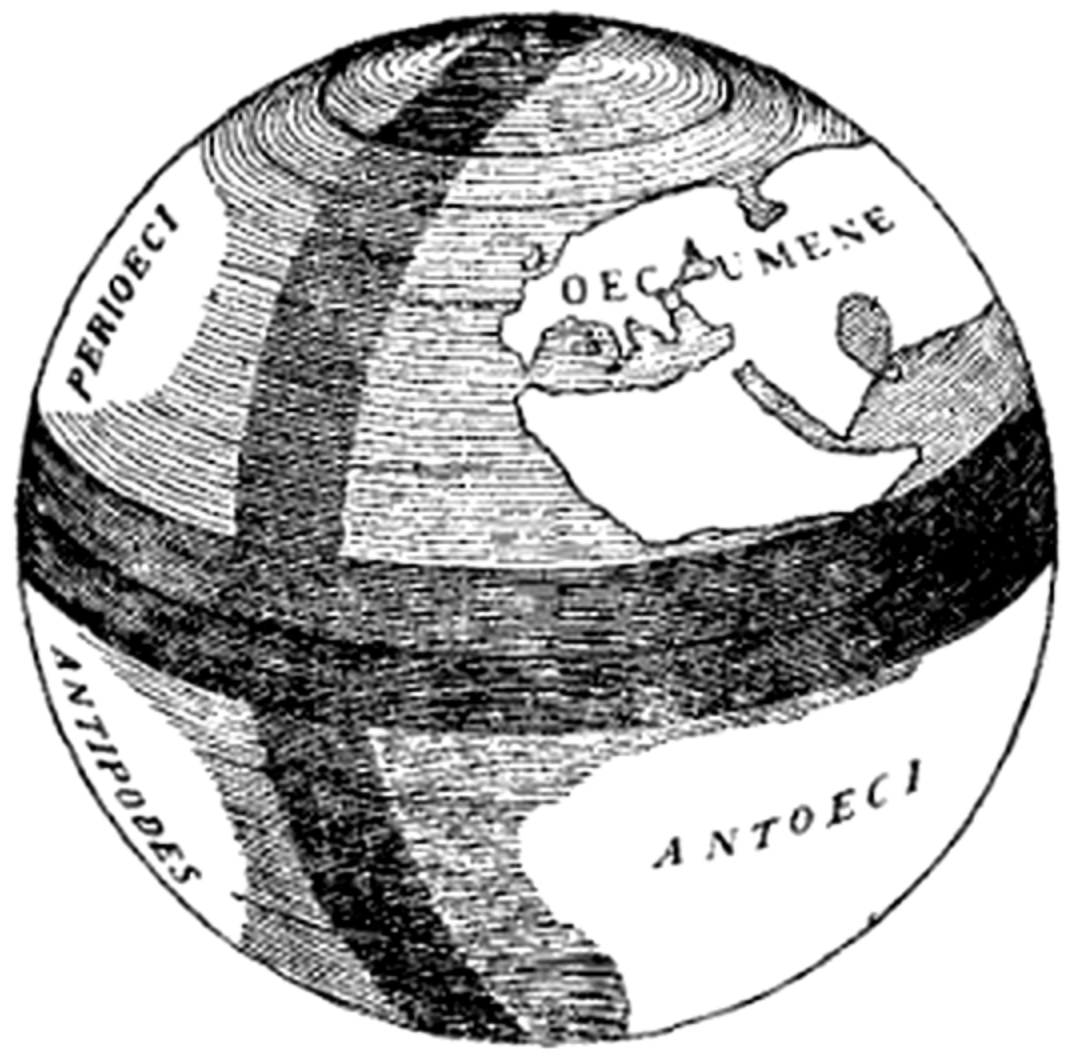|
Globe
A globe is a spherical model of Earth, of some other celestial body, or of the celestial sphere. Globes serve purposes similar to maps, but unlike maps, they do not distort the surface that they portray except to scale it down. A model globe of Earth is called a terrestrial globe. A model globe of the celestial sphere is called a ''celestial globe''. A globe shows details of its subject. A terrestrial globe shows landmasses and water bodies. It might show nations and major cities and the network of latitude and longitude lines. Some have raised relief to show mountains and other large landforms. A celestial globe shows notable stars, and may also show positions of other prominent astronomical objects. Typically, it will also divide the celestial sphere into constellations. The word ''globe'' comes from the Latin word ''globus'', meaning "sphere". Globes have a long history. The first known mention of a globe is from Strabo, describing the Globe of Crates from about 1 ... [...More Info...] [...Related Items...] OR: [Wikipedia] [Google] [Baidu] |
Celestial Globe
Celestial globes show the apparent positions of the stars in the sky. They omit the Sun, Moon, and planets because the positions of these bodies vary relative to those of the stars, but the ecliptic, along which the Sun moves, is indicated. There is an issue regarding the “ handedness” of celestial globes. If the globe is constructed so that the stars are in the positions they actually occupy on the imaginary celestial sphere, then the star field will appear reversed on the surface of the globe (all the constellations will appear as their mirror images). This is because the view from Earth, positioned at the centre of the celestial sphere, is of the gnomonic projection inside of the celestial sphere, whereas the celestial globe is orthographic projection as viewed from the outside. For this reason, celestial globes are often produced in mirror image, so that at least the constellations appear as viewed from earth. Some modern celestial globes address this problem by ... [...More Info...] [...Related Items...] OR: [Wikipedia] [Google] [Baidu] |
Map Projection
In cartography, map projection is the term used to describe a broad set of transformations employed to represent the two-dimensional curved surface of a globe on a plane. In a map projection, coordinates, often expressed as latitude and longitude, of locations from the surface of the globe are transformed to coordinates on a plane. Projection is a necessary step in creating a two-dimensional map and is one of the essential elements of cartography. All projections of a sphere on a plane necessarily distort the surface in some way and to some extent. Depending on the purpose of the map, some distortions are acceptable and others are not; therefore, different map projections exist in order to preserve some properties of the sphere-like body at the expense of other properties. The study of map projections is primarily about the characterization of their distortions. There is no limit to the number of possible map projections. More generally, projections are considered in sev ... [...More Info...] [...Related Items...] OR: [Wikipedia] [Google] [Baidu] |
Martin Behaim
Martin Behaim (6 October 1459 – 29 July 1507), also known as and by various forms of , was a German textile merchant and cartographer. He served John II of Portugal as an adviser in matters of navigation and participated in a voyage to West Africa. He is now best known for his Erdapfel, the world's oldest surviving globe, which he produced for the Imperial City of Nuremberg in 1492. Biography Behaim was born in Nuremberg on 6 October 1459, the oldest son of Martin Behaim and Agnes Schopper. The elder Martin was a merchant involved in long-distance trade within Europe, including Venice; in 1461 he was elected a senator of Nuremberg. Their son, as a member of a prominent and prosperous family, likely received a good education at one of the best grammar schools in the city. Contrary to later assertions, it is unlikely that he was ever a student of the famous Renaissance mathematician and astronomer, Regiomontanus.Görz, 2007Ravenstein, 1908 When his father died in 1474, Ma ... [...More Info...] [...Related Items...] OR: [Wikipedia] [Google] [Baidu] |
Erdapfel
__NOTOC__ The (; ) is a terrestrial globe produced by Martin Behaim from 1490–1492. The Erdapfel is the oldest surviving terrestrial globe. It is constructed of a laminated linen ball in two halves, reinforced with wood and overlaid with a map painted on gores by Georg Glockendon. The map was drawn on paper, which was pasted on a layer of parchment around the globe. The Americas are not included, as Columbus returned to Spain no sooner than March 1493. The globe shows an enlarged Eurasian continent and an empty ocean between Europe and Asia. The mythical Saint Brendan's Island is included. Cipangu ( Japan) is oversized and well south of its true position; Martellus's map is followed in developing an enormous phantom peninsula east of the Golden Chersonese ( Malaysia). The idea to call the globe "apple" may be related to the Reichsapfel ("Imperial Apple", Globus cruciger) which was also kept in Nuremberg along with the Imperial Regalia ( Reichskleinodien). The name ... [...More Info...] [...Related Items...] OR: [Wikipedia] [Google] [Baidu] |
Farnese Atlas
The Farnese Atlas is a 2nd-century AD Roman marble sculpture of Atlas holding up a celestial globe. Probably a copy of an earlier work of the Hellenistic period, it is the oldest extant statue of Atlas, a Titan of Greek mythology who is represented in earlier Greek vase painting, and the oldest known representation of the celestial spheres and the classical constellations. The sculpture is at the National Archaeological Museum of Naples, in Italy. The statue is dated around AD 150, during the Roman Empire and after the composition of the '' Almagest'' by Claudius Ptolemy, but the celestial globe has long been presumed to represent constellations mapped in earlier Hellenistic astrology, particularly in the work of Hipparchus in the 2nd century BC. Atlas labors under the weight because he had been sentenced by Zeus to hold up the sky. The sphere shows a depiction of the night sky as seen from outside the outermost celestial sphere, with low reliefs depicting 41 (some sou ... [...More Info...] [...Related Items...] OR: [Wikipedia] [Google] [Baidu] |
Crates Of Mallus
Crates of Mallus ( grc-gre, Κράτης ὁ Μαλλώτης, ''Krátēs ho Mallṓtēs''; century BC) was a Greek grammarian and Stoic philosopher, leader of the literary school and head of the library of Pergamum. He was described as the Crates from Mallus to distinguish him from other philosophers by the same name. His chief work was a critical and exegetical commentary on Homer. He is also famous for constructing the earliest known globe of the Earth. Life He was born in Mallus in Cilicia, and was brought up at Tarsus, and then moved to Pergamon, and there lived under the patronage of Eumenes II, and Attalus II. He was the founder of the Pergamon school of grammar, and seems to have been at one time the head of the library of Pergamon. Among his followers were Hermias (Κρατήτειος Ἑρμείας mentioned in sch. Hom. ''Il''. 16.207a), Zenodotus of Mallus and Herodicus of Babylon. He visited Rome as ambassador of either Eumenes, in 168 BC, or Attalus ... [...More Info...] [...Related Items...] OR: [Wikipedia] [Google] [Baidu] |
Celestial Sphere
In astronomy and navigation, the celestial sphere is an abstract sphere that has an arbitrarily large radius and is concentric to Earth. All objects in the sky can be conceived as being projected upon the inner surface of the celestial sphere, which may be centered on Earth or the observer. If centered on the observer, half of the sphere would resemble a hemispherical screen over the observing location. The celestial sphere is a conceptual tool used in spherical astronomy to specify the position of an object in the sky without consideration of its linear distance from the observer. The celestial equator divides the celestial sphere into northern and southern hemispheres. Introduction Because astronomical objects are at such remote distances, casual observation of the sky offers no information on their actual distances. All celestial objects seem equally far away, as if fixed onto the inside of a sphere with a large but unknown radius, which appears to rotate westward ... [...More Info...] [...Related Items...] OR: [Wikipedia] [Google] [Baidu] |
Earth
Earth is the third planet from the Sun and the only astronomical object known to harbor life. While large volumes of water can be found throughout the Solar System, only Earth sustains liquid surface water. About 71% of Earth's surface is made up of the ocean, dwarfing Earth's polar ice, lakes, and rivers. The remaining 29% of Earth's surface is land, consisting of continents and islands. Earth's surface layer is formed of several slowly moving tectonic plates, which interact to produce mountain ranges, volcanoes, and earthquakes. Earth's liquid outer core generates the magnetic field that shapes the magnetosphere of the Earth, deflecting destructive solar winds. The atmosphere of the Earth consists mostly of nitrogen and oxygen. Greenhouse gases in the atmosphere like carbon dioxide (CO2) trap a part of the energy from the Sun close to the surface. Water vapor is widely present in the atmosphere and forms clouds that cover most of the planet. More s ... [...More Info...] [...Related Items...] OR: [Wikipedia] [Google] [Baidu] |
Metre
The metre ( British spelling) or meter ( American spelling; see spelling differences) (from the French unit , from the Greek noun , "measure"), symbol m, is the primary unit of length in the International System of Units (SI), though its prefixed forms are also used relatively frequently. The metre was originally defined in 1793 as one ten-millionth of the distance from the equator to the North Pole along a great circle, so the Earth's circumference is approximately km. In 1799, the metre was redefined in terms of a prototype metre bar (the actual bar used was changed in 1889). In 1960, the metre was redefined in terms of a certain number of wavelengths of a certain emission line of krypton-86. The current definition was adopted in 1983 and modified slightly in 2002 to clarify that the metre is a measure of proper length. From 1983 until 2019, the metre was formally defined as the length of the path travelled by light in a vacuum in of a second. After the 2019 redefini ... [...More Info...] [...Related Items...] OR: [Wikipedia] [Google] [Baidu] |
Circle Of Latitude
A circle of latitude or line of latitude on Earth is an abstract east– west small circle connecting all locations around Earth (ignoring elevation) at a given latitude coordinate line. Circles of latitude are often called parallels because they are parallel to each other; that is, planes that contain any of these circles never intersect each other. A location's position along a circle of latitude is given by its longitude. Circles of latitude are unlike circles of longitude, which are all great circles with the centre of Earth in the middle, as the circles of latitude get smaller as the distance from the Equator increases. Their length can be calculated by a common sine or cosine function. The 60th parallel north or south is half as long as the Equator (disregarding Earth's minor flattening by 0.335%). On the Mercator projection or on the Gall-Peters projection, a circle of latitude is perpendicular to all meridians. On the ellipsoid or on spherical projecti ... [...More Info...] [...Related Items...] OR: [Wikipedia] [Google] [Baidu] |
Mount Everest
Mount Everest (; Tibetan: ''Chomolungma'' ; ) is Earth's highest mountain above sea level, located in the Mahalangur Himal sub-range of the Himalayas. The China–Nepal border runs across its summit point. Its elevation (snow height) of was most recently established in 2020 by the Chinese and Nepali authorities. Mount Everest attracts many climbers, including highly experienced mountaineers. There are two main climbing routes, one approaching the summit from the southeast in Nepal (known as the "standard route") and the other from the north in Tibet. While not posing substantial technical climbing challenges on the standard route, Everest presents dangers such as altitude sickness, weather, and wind, as well as hazards from avalanches and the Khumbu Icefall. , over 300 people have died on Everest, many of whose bodies remain on the mountain. The first recorded efforts to reach Everest's summit were made by British mountaineers. As Nepal did not allow foreigner ... [...More Info...] [...Related Items...] OR: [Wikipedia] [Google] [Baidu] |
Spherical Earth
Spherical Earth or Earth's curvature refers to the approximation of figure of the Earth as a sphere. The earliest documented mention of the concept dates from around the 5th century BC, when it appears in the writings of Greek philosophers. In the 3rd century BC, Hellenistic astronomy established the roughly spherical shape of Earth as a physical fact and calculated the Earth's circumference. This knowledge was gradually adopted throughout the Old World during Late Antiquity and the Middle Ages.Continuation into Roman and medieval thought: Reinhard Krüger:Materialien und Dokumente zur mittelalterlichen Erdkugeltheorie von der Spätantike bis zur Kolumbusfahrt (1492)Direct adoption by India: D. Pingree: "History of Mathematical Astronomy in India", ''Dictionary of Scientific Biography'', Vol. 15 (1978), pp. 533–633 (554f.); Glick, Thomas F., Livesey, Steven John, Wallis, Faith (eds.): "Medieval Science, Technology, and Medicine: An Encyclopedia", Routledge, New York ... [...More Info...] [...Related Items...] OR: [Wikipedia] [Google] [Baidu] |









